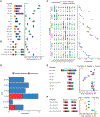Synthetic regulatory genomics uncovers enhancer context dependence at the Sox2 locus
- PMID: 36931273
- PMCID: PMC10081970
- DOI: 10.1016/j.molcel.2023.02.027
Synthetic regulatory genomics uncovers enhancer context dependence at the Sox2 locus
Abstract
Sox2 expression in mouse embryonic stem cells (mESCs) depends on a distal cluster of DNase I hypersensitive sites (DHSs), but their individual contributions and degree of interdependence remain a mystery. We analyzed the endogenous Sox2 locus using Big-IN to scarlessly integrate large DNA payloads incorporating deletions, rearrangements, and inversions affecting single or multiple DHSs, as well as surgical alterations to transcription factor (TF) recognition sequences. Multiple mESC clones were derived for each payload, sequence-verified, and analyzed for Sox2 expression. We found that two DHSs comprising a handful of key TF recognition sequences were each sufficient for long-range activation of Sox2 expression. By contrast, three nearby DHSs were entirely context dependent, showing no activity alone but dramatically augmenting the activity of the autonomous DHSs. Our results highlight the role of context in modulating genomic regulatory element function, and our synthetic regulatory genomics approach provides a roadmap for the dissection of other genomic loci.
Keywords: CTCF; enhancers; gene regulation; genetic engineering; genome writing; stem cells; synthetic regulatory genomics.
Copyright © 2023 Elsevier Inc. All rights reserved.
Conflict of interest statement
Declaration of interests R.B., J.D.B., and M.T.M. are listed as inventors on a patent application describing Big-IN. J.D.B. is a founder and Director of CDI Labs, Inc., a founder of and consultant to Neochromosome, Inc., a founder of, SAB member of, and consultant to ReOpen Diagnostics, LLC, and serves or served on the Scientific Advisory Board of the following: Logomix, Inc., Sangamo, Inc., Modern Meadow, Inc., Rome Therapeutics, Inc., Sample6, Inc., Tessera Therapeutics, Inc., and the Wyss Institute.
Figures






References
Publication types
MeSH terms
Substances
Grants and funding
LinkOut - more resources
Full Text Sources
Molecular Biology Databases
Research Materials
Miscellaneous

